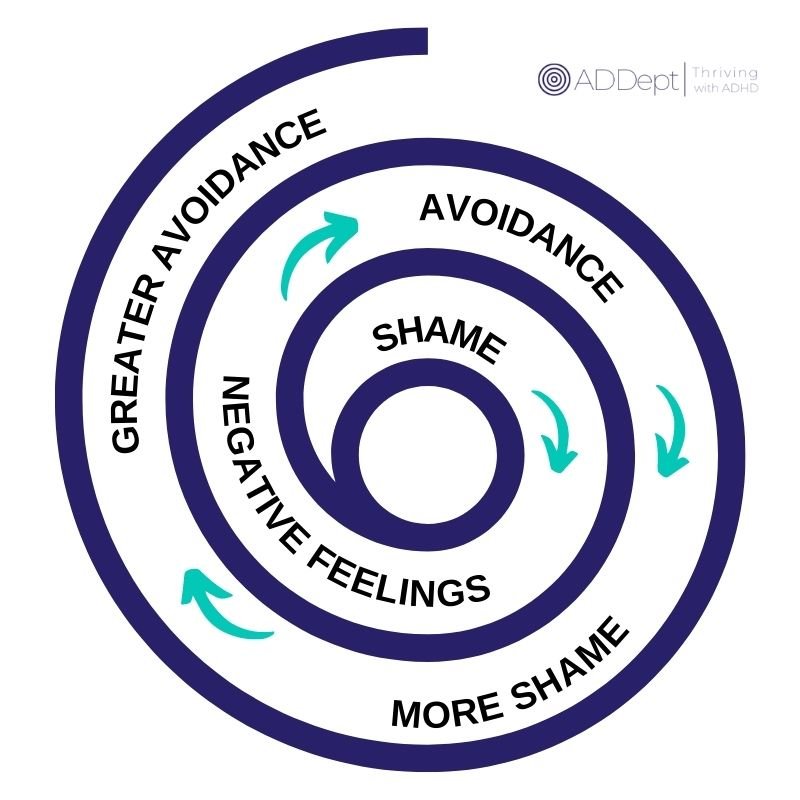ADHD and Shame
The 2 magic keys to reversing a shame spiral
"I'm late (feels a little guilty)… I'm always late…everyone is going to notice …Why is everyone else able to do life?… Why am I such a failure?…. If I just tried harder… Everyone else can do this…what is wrong with me?… I should just stay home …what's the point of going in when I know I won't be able to do it anyway? …I can't do this, I'm going back to bed."
Sound familiar?
It's the negative thought vortex known as a shame spiral and it's in full maelstrom mode- sucking you, your productivity, and your mood down with it.
I hear some version of this several times a day from my clients, my kids, my friends, heck- I hear it in my own brain on a bad day too. It's pretty universal. One minor mistake kicks the bruise created by repeated similar mistakes throughout life, dragging along with it a wall of shame created by a lifetime of criticism and self-blame.
This shame is so unbearable people usually turn away, put their hands over their ears, pull the covers over their heads, and try to turn off the world and their brains.
Think you might have ADHD?
Take a free online assessment to find out.
(Takes 3 minutes)
TAKE THE QUIZADHD and Shame: The Productivity Killer
The ADHD brain is particularly vulnerable to this spiral. For many, it's because even a minor mistake can trigger rejection sensitivity bringing along with it a wall of shame, hopelessness, and depression.
As if that wasn’t bad enough, all these bad feelings- they then tank our productivity.
Because of that shame, hopelessness, and depression? It feels terrible, and we don’t want to feel terrible, so we try to turn it off.
We hide, we avoid, and we turn away from the thing that feels so bad- desperately turning to whatever is brightest, shiniest, and most absorbing.
This works for a while, but eventually, we realize what we are doing, and the implications of hiding from that meeting, avoiding that paper, or skipping that quiz, start to seep in.
This triggers a whole new set of negative feelings, and now our numbed-out distraction is invaded by feelings of shame once again- deepening the spiral and often sending us into even more absorbing distractions.
Why is this all such a tangled web of productivity and mood-killing destruction?
Well, it all comes down to something psychologists call the Cognitive Triangle.
The Cognitive Triangle
The cognitive triangle is the powerful interconnection of thoughts, feelings, and behaviors- each one impacting the others in turn.
Now, in the shame spiral, this interconnection is really bad news. Negative thoughts lead to negative feelings, which then lead to avoiding and negative behaviors. When one goes down, the others follow suit.
But you know what? As bad as that all is- the flip side is powerful and offers a ton of hope and possibility, too.
Because as bad as our negative thoughts and avoidant behaviors can make us feel– our positive thoughts and behaviors make us feel just as good.
Or, at the very least, they stop us from feeling worse.
So, that powerful triangle that spirals down our thoughts, feelings, and behaviors? It’s also the magic key to halting a spiral, turning around a bad day, or even just starting our day out on the right foot.
When we have positive thoughts (even about our mistakes), our feelings transform from hopeless to hopeful, and we feel more capable and more in control. Like we can tackle what we need to fix the problem.
How to turn around a Shame Spiral
Because we don’t have the ability to consciously and directly control our feelings, the power of our cognitive triad lives in our thoughts and our actions. Let’s look at how to use each one to turn that negative vortex into an upward spiral that kicks you right out of shame.
The power of thoughts in the real world:
Compare these 2 thought patterns:
"I don't have time to do this...I can't believe I waited so long- again…it's going to be horrible, and everyone is going to know that I don't have what it takes…Ugh, I can't face this."
"Wow. I really don't have much time…I wish I had started earlier…But, that’s really hard for my brain… I'll try to figure out how to start earlier next time, but this time? Well, let's see- what do I have to do? Exactly how much time do I have? Do I have any wiggle room?… Okay, I can do this. I’ve done it before. Let's go!"
The first one makes me want to crawl back under the covers, just writing it.
The second one? That one has hope, it has a plan, and it has some calm confidence.
The person having those thoughts is likely to get started; they may not complete the project or at least not as they wanted to, but they’re likely to get a good bit done and may find a way to make that be enough.
You know what else? The second one is much more likely to result in some changed behaviors to make this pattern not happen in the same way the next time because they didn't throw up their hands and say that they can never do it. In essence, they approached it as if it is (in Marie Forleo's words) "figureoutable."
Changing thoughts, while a simple concept, is a challenging proposition. It takes conscious effort, and it doesn't always feel true or real. But- you know the cool thing? It doesn't even need to feel 100% accurate to have an impact on your feelings.
Even if you say to yourself, "It's okay, I know I'm trying, I can figure this out," and it rings a little hollow? That's okay- first of all, the more you say it, the stronger it will feel; second of all, even a hollow reassurance can stop a shame spiral.
The power of behavior:
But changing your thoughts isn't the only key you have in this vortex of shame– Behaviors work too.
Avoidance behaviors:
Feeling bad about yourself? Sure- the impulse is to run as far away from those feelings as you can. TV, internet, social media, shopping, sex, alcohol- all these things are bright and shiny numbing agents. They allow us to get absorbed in something long enough that they give us a momentary reprieve. The problem with them is that they tend to drain our energy, and so we return to the issue at hand, now with less time and even fewer resources to deal with it.
Fueling Breaks
A fueling break gives us the space we need to get some clarity while also giving us the resources to address the issue.
What things can you do for yourself (or someone else) that fuels you? Maybe you can take a quick walk around the block, call a friend, cook a meal for a homeless shelter, visit your grandmother, work on a creative project, or get on the floor and play with your kids. All of these things offer both perspectives as well as fuel.
Facing the problem:
I know. It's hard to DO things when you are feeling bad. Your ADHD brain has been slogging through a swamp of shame, which drained the little bit of energy your conductor had, and now a walk around the block might as well be a brisk run-up to Mt Everest. That means it is extra essential to reach into your bag of ADHD tricks: tell yourself you only need to take 2 steps (breaking the task down), call a friend to take a walk with you (accountability), or make your walk end at your favorite juice bar (using reward).
The Power of a Plan
All of these things will be easier if you think about them in advance. It's hard to think of good things to do when you are in a bad spot. It's like trying to figure out something healthy to eat when you’re starving- the donut sounds so much more appealing. So, give yourself the advantage of a pre-made menu that you can select from in these tough spots.
What are some behaviors that you can do that would offer you both perspective and fuel when you are in a shame spiral?
Try to come up with a few that fit different situations and time frames, so some that are quick, some that are longer, some that involve others, some that you can do on your own, some that require physical activity, and some that you can do seated. This way, you have something on your menu to fit most situations.
Write them down. No. Really. Take a moment, brainstorm a list, and write them down. Then take a picture, or add them to the notes section on your phone- whatever you need to do to have them be accessible when your brain is worn down and tired from spiraling.
That way, the next time you are feeling bad, you can look at what your thoughts and behaviors were doing. Were you headed into a spiral? Can you give yourself a mental hug? Can speak gently and kindly to yourself? Next, look at your list and see what you can DO to fuel yourself and your perspective. You have the power to turn the spiral around at any point. Is it hard? Yes. But you can do hard things.
Want to add some more tools to that shame-fighting toolbag? Check out 3 steps for conquering your inner critic.
Ready to shift from
meltdown to mastery?
This online course has been designed specifically to help teach the strategies ADHD brains need to help them move from overwhelm and meltdowns to confident emotional mastery.
Want to know more about
thriving with ADHD?
Check out these other articles:













ADHD and Shame: The 2 magic keys to reversing a shame spiral